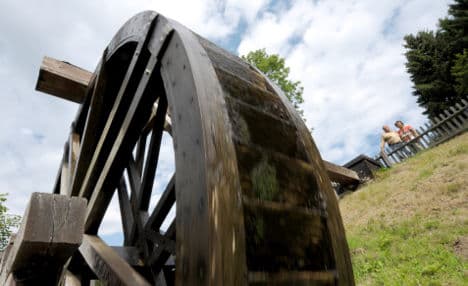Mine of Rammelsberg and Goslar town

As the summer holidays approach, The Local is touring Germany's UNESCO World Heritage Sites. Today we visit the historic mine of Rammelsberg and town of Goslar.
One thousand years of mining history are documented in the museum at the disused mines of Rammelsberg which were closed in 1988. Now a visitor mine, it is one of the largest museums in Germany with numerous mining industry artefacts from various historical periods on display.
These include: the slag heaps (10th century), the Rathstiefste Stollen mine (one of the oldest and best-preserved mines in Germany, 12th century), the Feuergezäher Gewölbe (the oldest, brick-lined underground chamber in Europe, 13th century), the Maltermeisterturm (the oldest surface mining building in Germany, 15th century), the Roeder Stollen mine (18th/19th century) with two original water wheels and the impressive open-cast mines (early 20th century).
Goslar's history and development were shaped by the rich Rammelsberg silver and copper ore deposits, which led to Emperor Heinrich II setting up his imperial court in the Palatinate at the beginning of the 11th century; with the first imperial assembly in Goslar taking place in 1009. Until 1253, Goslar was a royal seat for German kings and emperors.
The well-preserved heart of the medieval town of Goslar occupies a very confined space, just one square kilometre. The magnificent imperial palace was built in the Romanesque style and for many centuries its was the largest and safest fortress of the Saxon and Salian emperors.
Goslar was a centre for Christian faith, otherwise known as the "Rome of the North". The towers of the 47 churches and chapels form the unique skyline of the town. The townscape is dominated by the venerable town hall on the market square, a variety of guildhalls and numerous, supremely crafted timber-framed town houses. Both have been a UNESCO-World Heritage since 1992.
Comments
See Also
One thousand years of mining history are documented in the museum at the disused mines of Rammelsberg which were closed in 1988. Now a visitor mine, it is one of the largest museums in Germany with numerous mining industry artefacts from various historical periods on display.
These include: the slag heaps (10th century), the Rathstiefste Stollen mine (one of the oldest and best-preserved mines in Germany, 12th century), the Feuergezäher Gewölbe (the oldest, brick-lined underground chamber in Europe, 13th century), the Maltermeisterturm (the oldest surface mining building in Germany, 15th century), the Roeder Stollen mine (18th/19th century) with two original water wheels and the impressive open-cast mines (early 20th century).
Goslar's history and development were shaped by the rich Rammelsberg silver and copper ore deposits, which led to Emperor Heinrich II setting up his imperial court in the Palatinate at the beginning of the 11th century; with the first imperial assembly in Goslar taking place in 1009. Until 1253, Goslar was a royal seat for German kings and emperors.
The well-preserved heart of the medieval town of Goslar occupies a very confined space, just one square kilometre. The magnificent imperial palace was built in the Romanesque style and for many centuries its was the largest and safest fortress of the Saxon and Salian emperors.
Goslar was a centre for Christian faith, otherwise known as the "Rome of the North". The towers of the 47 churches and chapels form the unique skyline of the town. The townscape is dominated by the venerable town hall on the market square, a variety of guildhalls and numerous, supremely crafted timber-framed town houses. Both have been a UNESCO-World Heritage since 1992.
Join the conversation in our comments section below. Share your own views and experience and if you have a question or suggestion for our journalists then email us at [email protected].
Please keep comments civil, constructive and on topic – and make sure to read our terms of use before getting involved.
Please log in here to leave a comment.